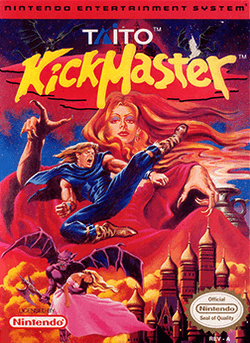Kick Master
| Kick Master | |
|---|---|
 Cover art (Thonolan, Belzed, and Silphee) | |
| Developer(s) | KID |
| Publisher(s) | Taito |
| Director(s) |
Hisayoshi Ichikawa Motoyuki Inoue |
| Producer(s) | Ken Lobb |
| Programmer(s) | Shinobu Yagawa |
| Artist(s) |
Kazuhiro Iizuka Tsutomu Ozawa |
| Composer(s) |
Nobuyuki Shioda Yusuke Takahama |
| Platform(s) | NES |
| Release date(s) |
|
| Genre(s) | Action |
| Mode(s) | Single-player |
Kick Master (also known as KickMaster) is an action game developed by KID and published by Taito Corporation for the Nintendo Entertainment System in 1992. The game has some role-playing game elements, such as leveling up.
Gameplay
Kick Master resembles early games in the Castlevania series.[1][2] Enemies are fought using martial arts kicks and magic spells. Defeated enemies drop three items that will either help or hurt the player character Thonolan. When Thonolan gains a level, his maximum MP is increased and new moves are learned.
Plot
The castle of Lowrel is attacked and burned by the monsters and magic of the powerful evil witch Belzed (curiously, Western sources such as Nintendo Power described Belzed as a male wizard[3]). In the attack, the King and the Queen are slain and their only child, Princess Silphee, is kidnapped. The king's guards were all killed, except for the knight Macren. He and his younger brother, Thonolan, an aspiring martial artist, take off on a long journey to free the princess. As the fight against Belzed's minions commences, Macren is mortally wounded by a skeleton. With his dying breath, he pleads his brother to use his "great kicking skills" to avenge him.
If the player manages to complete the game, the wicked Belzed is destroyed and Thonolan rescues the princess Silphee. He then torches down the witch's tower and disappears, never to be heard from again. The player is then given an opportunity to try to beat the game again on a higher difficulty level. There are a total of three difficulty levels in this game. Once the third difficulty level is complete, the credits will roll.
Reception
Video game magazines, such as GamePro,[4] gave Kick Master positive reviews upon the release. Nevertheless, the game did not become very well known.[5]
References
- ↑ Mateusz Gołębiowski. "Retro - Kick Master - Felieton". Gry.wp.pl. Retrieved 2016-06-26.
- ↑ "Retronauts: 1UP's Classic Gaming Blog : Giving Evil the Boot with Kickmaster". 1up.com. Retrieved 2016-06-26.
- ↑ "Nintendo Power Issue 028 September 1991". Archive.org. Retrieved 2016-06-26.
- ↑ "GamePro Issue 031 February 1992". Archive.org. Retrieved 2016-06-26.
- ↑ "Archived copy". Archived from the original on February 1, 2011. Retrieved March 9, 2011.
External links
- Kick Master at MobyGames
- Kick Master at Hardcore Gaming 101
- Kick Master at Something Awful